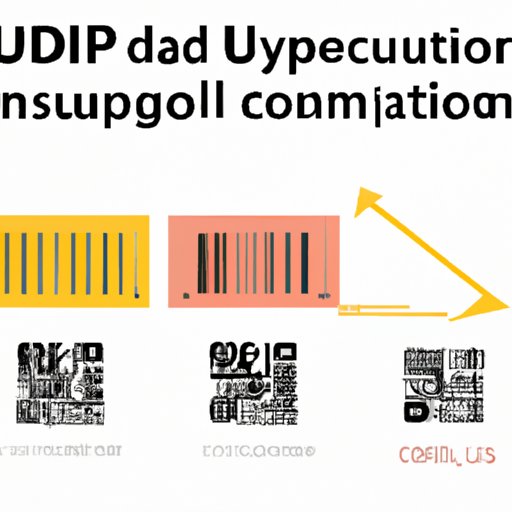Introduction
Have you ever wondered what those black and white bars on the packaging of your favorite products are for? Those are UPC codes, which are vital for product identification and tracking. Every product in a retail store requires a unique code, and UPC codes are the most commonly used system for this purpose. In this article, we will delve into the intricacies of UPC codes and their importance in modern commerce.
An Introduction to UPC Codes: What They Are and How They Work
A UPC (Universal Product Code) code is a specific type of barcode that identifies and tracks products in retail stores worldwide. A UPC code is composed of a series of bars and spaces, along with a 12-digit number that is unique to each product. The code is usually found on the product’s packaging and can be scanned at checkouts to record its price and other important information.
UPC codes consist of three main components. The first component is the manufacturer code, which is assigned to the producer of the product. The second is the product code, which identifies the specific product type. Finally, the check digit is used to verify that the barcode has been correctly scanned and is not counterfeit.
Reading a UPC code is a simple process that involves scanning the code with a barcode reader, which then decodes the information as a 12-digit number. Each digit corresponds to a specific element of the code, which can be used to identify the product and complete the transaction.
The Importance of Understanding UPC Codes for Retailers and Consumers Alike
UPC codes are essential for retailers and manufacturers for several reasons. The primary benefit is the ability to track inventory and sales data in real-time, which allows businesses to make informed decisions about products and their profitability. This also benefits consumers by ensuring that popular products are always available, and prices are competitive.
UPC codes also facilitate the distribution of products nationwide and globally. The use of standardized codes allows products to be easily identified and tracked across various supply chain channels. This means that manufacturers can quickly and efficiently move their products to different locations, ensuring that they reach their target audiences.
Lastly, UPC codes enable modern e-commerce. With more customers shopping online than ever before, the need for efficient product identification and tracking has never been greater. UPC codes streamline the buying process, making it easier for customers to find and purchase the products they want online.
Everything You Need to Know About UPC Codes and Product Identification
Product identification is essential for retailers and manufacturers alike, and UPC codes are the most widely used system for this purpose. Each product has a unique barcode that makes it easy for businesses to keep track of their inventory and re-order products when necessary. Additionally, UPC codes help prevent counterfeiting, as each product is given a unique, easily identifiable code.
UPC codes are used across a wide range of industries, from food and beverage to consumer electronics and apparel. They provide a standardized method of identifying products, which means that businesses of all sizes can benefit from using this system.
A Comprehensive Guide to Decoding UPC Barcodes and Identifying Products
UPC barcodes use specific symbologies to encode information. Each symbology provides a different way of encoding data, with some being more complex than others. Examples of UPC barcode symbologies include UPC-A, UPC-B, and UPC-E.
To read and interpret a UPC barcode, businesses use a barcode scanner, which captures the barcode’s image and translates it into a 12-digit number. This number can then be used to identify the product and complete the transaction.
Common applications of UPC barcode decoding include inventory management, product tracking, and point-of-sale transactions. By streamlining these processes, businesses can save time and money, while giving customers a more efficient shopping experience.

The Evolution of UPC Codes: From Basic Barcodes to Complex Data Structures
The first UPC code was developed in the 1970s by the Uniform Product Code Council, which later became the GS1 US. Since then, UPC codes have undergone several changes, with the introduction of new symbologies and advances in barcode scanning technology.
The most significant change in UPC codes in recent years has been the adoption of 2D barcodes, which offer a higher level of data storage and can provide additional product information to consumers. Additionally, the use of smartphones has made it easier for customers to scan barcodes and access product information online, which has led to the development of new marketing strategies and customer engagement tools.
UPC Codes and the Future of Digital Product Tracking: An Analysis
The future of UPC codes is closely tied to the development of digital product tracking. With advances in technology such as RFID (Radio-Frequency Identification) and blockchain, businesses can now track products at every stage of the supply chain, from production to retail.
The use of UPC codes in digital product tracking has many benefits, including increased efficiency and accuracy, reduced costs, and greater transparency. It also helps businesses take a proactive approach to counterfeit prevention, as products can be easily tracked and traced, even after they leave the production facility.
As the use of digital product tracking becomes more widespread, it is likely that UPC codes will continue to play a vital role in this process. Businesses that stay up-to-date with the latest advances in technology and product tracking will be better equipped to succeed in the years to come.
Conclusion
UPC codes have revolutionized the way that products are identified and tracked in retail stores worldwide. They provide a standardized method of product identification, ensuring that each product has a unique barcode that can be used to track inventory, sales data, and profitability. They are also essential for e-commerce, allowing customers to shop online with ease.
As advances in technology continue to shape the way that products are produced and distributed, it is likely that UPC codes will continue to evolve. By keeping up-to-date with the latest developments in product identification and tracking, businesses can stay ahead of the competition and better serve their customers.
